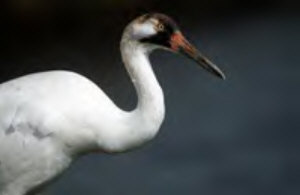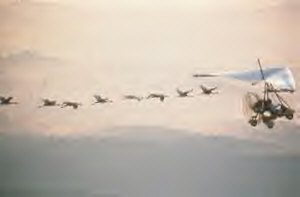Whooping Cranes From Michigan First In South Carolina Since 1850
|
||||||||||
| Printer Friendly Story View |

Five foot tall whooping crane, with six foot wingspan, has distinctive crimson crown.

Intrepid ultra-light pilots approach stratosphere as they lead cranes on long trek South.
(EDITOR'S NOTE: In our opinion this one of the most amazing stories of wildlife preservation in American history. The story involves the incredible aspect of pilots flying ultra-light aircraft to "teach" the cranes how to migrate. The five foot high whooping crane, tallest bird in North America, was reduced by hunting and other human intrusions to 16 birds in 1941. Now through the efforts of conservationists there are an estimated 452 birds.)
The first of eastern North America's new migratory flock of wild whooping cranes has arrived at its winter home in Florida, the U.S. Fish and Wildlife Service has announced. Meanwhile, younger cranes, led by piloted ultra-light aircraft, continued progress on their first southward migration.
Five whooping cranes from the Class of 2003 that summered in Michigan are also on their way south for their first unassisted fall migration. Four Michigan birds detoured through South Carolina, stopped briefly on Cape Romain National Wildlife Refuge (NWR), along the Atlantic coast, before heading north into North Carolina.
These are the first whooping cranes in South Carolina in more than a century. The remains of one of the four, number 5-03, were found on Cape RomainNWR on Nov. 16. The cause of death is being investigated.
The Whooping Crane Eastern Partnership (WCEP), an international coalition of public and private groups, is organizing the effort to reintroduce this highly imperiled species in eastern North America, part of its historic range. WCEP is trying to establish a self-sustaining wild, migrating flock of whooping cranes in eastern North America.
Whooping cranes once ranged from the Artic Sea to the high plateau of central Mexico and from Utah east to South Carolina, Florida and New Jersey. At almost five feet in height, the whooper is the tallest bird in North America. Adults have snowy white plumage, a crimson crown, long thin black legs and six foot wings tipped in black.Juvenile birds are cinnamon and white. The call of the whooping crane carries for miles.
Whooping cranes are similar to sandhill cranes and could be mistakenly targeted by inexperienced hunters. Two whoopers were shot while migrating through Kansas in November, U.S. Fish and Wildlife Service officials said. One survived with treatment at Kansas State University and is now in breeding stock at the federal Patuxent Wildlife Research Center in Maryland. Sandhill crane season lasts into December in parts of Texas so hunters are urged to take extra care not to shoot the whoopers.
Whooping cranes winter in salt marshes and forage mainly for blue crabs. They are territorial and will chase all other whooping cranes out of their territories, estimated to range over 350 acres.
A wild flock of whooping cranes migrates between nests in Canada and Texas wintering grounds and is the only wild population left in the world. There are 318 birds in the wild flock and 134 in captivity, totaling 452.
A concern that a catastropic event at one nesting ground could wipe out the entire flock led to efforts to establish additional, separated populations. The Whooping Crane Recovery Team of biologists in 1999 recommendedthat a second migratory flock hatched in captivity be taught a migration route from central Wisconsin to the west coast of Florida. The recovery team decided to employ the ultra-light aircraft led migration techniques of Operation Migration, Inc.
In 2001, project partner Operation Migration's pilots led the first whooping crane chicks, conditioned to follow their ultra-light leaders south from Necedah NWR to Chassahowitzka NWR on Florida's Gulf Coast. In 2002, WCEP biologists and pilots conditioned and guided a second group of juvenile cranes to Chassahowitzka NWR.
Biologists tracking the migrating whoopers found crane 14 from the Class of 2002 at Chassahowitzka NWR on Nov. 16. She was the first of the wild birds to reach Florida.
The wild cranes were joined by a new traveling companion crane 18-04, the first young whooper to be conditioned behind the ultra-light aircraft and introduced among older birds to learn the migration route. Crane 18-04 was not able to complete the necessary conditioning to begin the ultralight-led migration on October 10.
In the fall of 2003, WCEP conducted its third ultra-light led migration. Those cranes have begun returning to their summer home in central Wisconsin, and there are now 35 whooping cranes in the wild in eastern North America.
WCEP asks anyone who encounters a whooping crane in the wild to please give them the respect and distance they need. Do not approach birds on foot within 600 feet; try to remain in your vehicle; do not approach in a vehicle within 600 feet or, if on a public road, within 300 feet. Also, please remain concealed and do not speak loudly enough that the birds can hear you. Finally, do not trespass on private property in an attempt to view whooping cranes.
WCEP founding members include the International Crane Foundation, Operation Migration Inc., Wisconsin Department of Natural Resources, U.S. Fish and Wildlife Service, the U.S. Geological Survey's Patuxent Wildlife Research Center and National Wildlife Health Center, the National Fish and Wildlife Foundation, the Natural Resources Foundation of Wisconsin, and the International Whooping Crane Recovery Team.
Many other flyway states, provinces, private individuals and conservation groups have joined forces with and support WCEP by donating resources, funding and personnel. More than 60 percent of the project's estimated $1.8 million budget comes from private sources in the form of grants, public donations and corporate sponsors.
This preliminary effort in 2004 will help prepare for supplemental releases in subsequent years. For more information on the project, its partners, and how you can help, visit the WCEP website at http://www.bringbackthecranes.org. For a real eye-opener about this amazing process, also check out www.operationmigration.org.###
| Printer Friendly Story View |
|
|

Dave Rogers |
|
|
|
Printer-Friendly Story View
0200 Nd: 04-15-2024 d 4 cpr 0
12/31/2020 P3v3-0200-Ad.cfm
SPONSORED LINKS
12/31/2020 drop ads P3v3-0200-Ad.cfm


